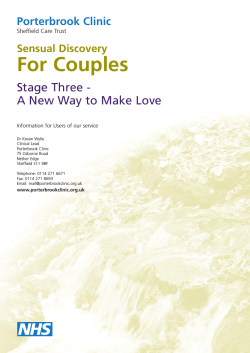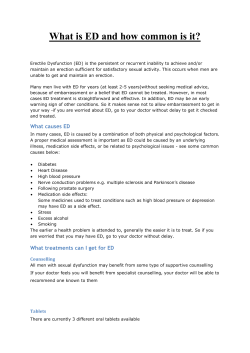
Unit 12: Intimate Relationships and Human Sexuality
Unit 12: Intimate Relationships and Human Sexuality Characteristics of intimate relationships • • • • • • • Love, sex and commitment Mutual trust and affection Realistic expectations: we’re not all perfect! Open communication Mutual respect Egalitarian roles They balance activities that they enjoy doing together and with others • Agreement on religious and ethical values Marriage • Married people are healthier and have longer longevity than non married people • Why? – Selection theory? – Protection theory? Take home message: Factors that increase chance of marriages lasting = Definition of LOVE (Merriam Webster) 1 a (1) : strong affection for another arising out of kinship or personal ties <maternal love for a child> (2) : attraction based on sexual desire : affection and tenderness felt by lovers (3) : affection based on admiration, benevolence, or common interests <love for his old schoolmates> b : an assurance of love <give her my love> 2 : warm attachment, enthusiasm, or devotion <love of the sea> 3 a : the object of attachment, devotion, or admiration <baseball was his first love> b (1) : a beloved person : darling —often used as a term of endearment (2) British —used as an informal term of address 4 a : unselfish loyal and benevolent concern for the good of another: as (1) : the fatherly concern of God for humankind (2) : brotherly concern for others b : a person's adoration of God 5 : a god or personification of love 6 : an amorous episode : love affair 7 : the sexual embrace : copulation 8 : a score of zero (as in tennis) Love More than just sex or that ‘high’ you feel when they are around Real love is based on caring and commitment “falling in love” is sometimes a ‘trick’, not necessarily real love Meant to make humans reproduce? “the will to extend one’s self for the purpose of nurturing one’s own or another’s spiritual growth” (Peck 1978) Human Sexuality! SEXUAL ANATOMY! WARNING: THERE ARE REAL PICTURES OF HUMAN GENITALIA ON THE FOLLOWING SLIDES. THERE ARE ALSO REAL ANATOMICAL DISSECTIONS OF CERTAIN SEXUAL ORGANS Male Anatomy • • • • The testes -produce sperm and testosterone Scrotum - encloses and protects the testes Epididymis – stores sperm Vas deferens - connects the epididymis with the urethra • Urethra – transports both semen and urine Male Reproductive Anatomy The Penis! Composed of three masses of erectile tissue When the spaces in the erectile tissue fill with blood = erection! The end of the penis is the very sensitive glans penis (7) The border of the glans penis is the even more sensitive corona On the posterior side of the penis, there is a small triangular indentation on the corona called the frenulum (6) *(where foreskin used to or does attach) The frenulum is believed to be the most sensitive part of the male penis! T&M 27.10 The Penis! Uncircumcised penis Male circumcision has been associated with decrease risk of STI’s and general infections. No conclusive evidence either way as to whether it decreases sensitivity The size of a man’s flaccid penis has no correlation with the size of his erect penis Does Size Matter? • Average male penis length varies between 5-6 inches erect • The first 5th of the female vagina has the most nerve endings • The size of the penis can ‘shrink’ due to cold temperature or nervousness • Survey of 52,031 heterosexuals found that 85% of women were satisfied with their partner’s penis size, only 55% of males were satisfied with their length Male Performance Concerns • Erectile Dysfunction- inability to achieve full erection or an erection at all • 2 main types – Physiological • Hormonal, age-related, side-effect of prescription drugs, alcohol, drugs, obesity • Associated with Diabetes, decreased testosterone – Constriction ring may help – Drugs can treat » Viagra allows the erectile tissue to become filled with blood – Psychological • Performance anxiety, stress, mental disorders Male Performance Concerns • Premature Ejaculation- when a man ejaculates before he wants to, to a point where it causes distress/concern • Treatments: – Practicing control/endurance during masturbation – The “squeeze technique” • When ejaculation is imminent, penis is squeezed between shaft and glans, until sensation disappears. • Wait 30 seconds • Resume fun! – Non-sexual thoughts – Swapping foreplay and sex throughout? – Yoga? – Topical aesthetic creams – Sexual therapy – Antidepressants – Psychotherapy Reproductive Female Anatomy Keywords • Egg/ ovum – meets sperm • Ovaries – produce estrogen – produce egg; released during ovulation • Fallopian tube – site of fertilization • Uterus – where the implanted fetus grows • Vagina – passageway for penis, child Female Reproductive Anatomy Vulva The Vulva is the term for the female external genitalia This entire area is a specific erogenous zone with increased density of sensory nerves – Consists of the: – Mons pubis – pubic region covered by hair – Labia (minora/majora) – inner and outer flaps of skin that cover the vagina – Clitoris – pleasure center!!! Labias come in all shapes, sizes and colours! Hymen A fold of mucous membrane that partially covers the vaginal opening until ruptured. When ruptured, bleeding may result The Clitoris! ‘‘a lucky stroke of fate that nature forgot to deactivate’’ -Stephen Jay Gould The visible clitoris is a small cylindrical mass of erectile tissue It has approx 8000 nerve endings It is covered externally by the prepuce of the clitoris (hood). The part of the clitoris you can see is the glans clitoris, however, believe it or not, most of the clitoris is internal (and it’s surprisingly gigantic!) It is the only organ in the human body whose ONLY purpose is pleasure! (and it’s ours!!! Ha!) All the rest = internal clitoris! The Penis vs the Clitoris Both the penis and clitoris develop from the same embryonic tissue, making them similar in structure Anatomy of the Clitoris Frontal plane The G-spot Note: not a distinct, anatomical location! This figure demonstrates its general area The “G-spot”!! • “Anterior wall erogenous complex”?? • It is widely accepted to be present in some females • However, evidence is not definitive, many gynaecologist/urologist refute its presence • Anatomical study of 110 vaginas (cadavers) found no distinct neurological area that could be described as a G-spot (Hines and by Pauls et al. (2006) – ‘a sort of gynecologic UFO: much sought for, much discussed, but unverified by objective means’ (Hines, 2001) The “G-spot”!! • An Italian study found that women who reported G-spot orgasms tended to have thicker vaginal walls • The location varies among females (if it’s there at all). It is in the general area of the anterior wall of the vagina, a few centimetres in • Best way to stimulate the region: • A) during foreplay: two fingers are inserted into the vagina and the anterior wall is palpated with a “come hither” motion. • B) during intercourse: woman on top or during rear entry (Ladas et al. 2005) • May be the region responsible for female ejaculation Female Ejaculation • Not fully understood in the scientific community • Emitted from some women during orgasm from the urethra or paraurethral glands (controversial) • NOT urination (although may contain traces); chemically similar to seminal fluid • Can inhibit orgasm for a woman if she believes she is about to urinate and stops herself • Anecdotal evidence has described the area that produces the response as a “ball” a few centimetres into the vagina, that enlarges once aroused, producing a sensation similar to the urge to urinate THE HUMAN SEXUAL RESPONSE Sex and Health • Palmore (1982) found that frequency of intercourse in males, not females increased longevity – Past enjoyment of intercourse increased longevity in females • American nuns had a 20% higher breast cancer risk than sexually active US females • Associated with increased immune function in males • Believed to be equivalent to a moderate bout of exercise Sex and Health • Penile-Vaginal intercourse (PVI) was a significant predictor of mental health satisfaction • PVI frequency/ orgasmic frequency positively associated with relationship quality components • Higher masturbation frequency is correlated with depression in several studies • PVI improves strength of pelvic floor muscles • PVI associated with protection from cardiovascular stress Erogenous Zones • Specific- have increased surface area of dermal layers, thus more sensory nerves – Penis, foreskin, perianal skin, lip, nipple, vulva, clitoris • Non-specific- similar to the other normal hairy skin nearby – Sides of back/neck, armpits, sides of lower back The Stages of the Sexual Response • Masters and Johnson (1966) were the first to propose the four stages of the sexual response • 1. Excitement 2. Plateau 3. Orgasm 4. Resolution The Male Sexual Response The Female Sexual Response Female vs. Male Sexual Response Males, unlike females, experience a refractory period following the response, during which another orgasm cannot be achieved. Females have a prolonged orgasm The female resolution stage may be longer The female is able to have multiple orgasms! Men are generally aroused more easily A female may not have an orgasm with intercourse alone. It is more often than not the case that she also requires stimulation of the clitoris to achieve orgasm The Elusive Female Orgasm: Physiological or Psychological? • In both males and females, the orgasm is typically evidenced by muscle contractions in the genital region accompanied by a ‘general sense of well-being’ • It is an autonomic response originating in the limbic system of the brain (associated with emotion, behaviour and longterm memory) • The quality and intensity of the female, not male, orgasm has been associated with the amount of loving emotion she feels towards her partner as evidenced by activation of specific brain regions The Elusive Female Orgasm: Physiological or Psychological? • The female orgasm may be more tied to emotional social bonding than in males – Oxytocin is a typically known as the hormone associated with childbirth/nursing in females – It is now also believed to play a significant role in human bonding and trust – Interestingly, there is a dramatic increase in secretion during both the male and female sexual response, but its secretion is only associated with the intensity of the female orgasm – It is also associated with increased vaginal lubrication in females – Its secretion also increases during foreplay, caresses or massages, kissing, hearing lover’s voice, loving thoughts – Implication: Women perhaps require stronger attachment bonds and/ or “warming up” in order to experience a strong orgasm The Female Orgasm from an Anatomical Perspective • Current conceptual models: – Away from the concept of a separate vaginal and clitoridian orgasm – Towards concept of a single anatomophysiological unit • Clitoris + anterior vagina (both swell during sex) + associated ligaments • “Anterior wall erogenous complex” ? – Possibly all of these parts participate in orgasm Female Sexual Dysfunction • Falls into 4 basic categories: – a low sex drive/aversion to sex – difficulty becoming aroused – inability to reach orgasm – pain during sex • Causes – physical (diabetes, obesity, CVD, low testosterone) – emotional (stress, fatigue, depression) – Mixture of 2 – Many drugs used to fight depression also reduce desire! (cruel irony) Yoga and sex • Yoga might improve sexual encounters since it: – Improves flexibility and balance – Improves strength – Improves aerobic stamina – Promotes awareness of the senses – Improves body awareness – Improves body image VARIATIONS IN SEXUAL BEHAVIOUR Sexual Behaviours of Young Adults Types of Sexual Activities According to Type of Relationship Acceptable Variations in sexual behaviour Masturbation Oral sex Anal sex Homosexuality Approx 4% males, 2% females homosexual Fetishes? Yes, but depends (ex. Paedophilia is a fetish) Commercial sex? (from a health perspective it’s acceptable, but it’s still debateable) Pornography prostitution Unacceptable Variations in Sexual Behaviour • Rape • Any sexual activity involving children • Forced prostitution
© Copyright 2025









